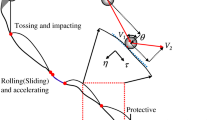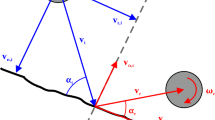Abstract
Different opinions exist in the current research on the COR (coefficient of restitution) of rockfall, and these controversies can be attributed to the difference in the reduction degree of the real impact process during research on rockfall disasters. According to the previous research results, six main controlling factors affecting the COR were comprehensively determined. In this paper, experiments about the effects of the main controlling factors on the COR were conducted; a specially designed rockfall ejector was able to simulate the real rockfall impact process, from which the correlations between the main controlling factors and COR were obtained and then validated by theoretical derivation. By means of the proposed deviation theory between the impact contact point and the projection of mass center, the effects of the block shape on COR values were reasonably explicated. Synthetically, considering the relationships between the characteristic index of surface area distribution and the geometry with normal COR (Rn), a new index for quantifying the block shape, i.e., shape factor, was introduced, which shows a significant linear correlation of classification with Rn. Not equated to IH (inclined impact on a horizontal slope) or II (inclined impact on an inclined slope) in impact experiments of rockfall, the COR values of VI (vertical impact on an incline slope) and its evolving trend with impact angle are varied. COR values are not linearly related to the impact angle completely; kinematic COR (Rv), tangential COR (Rt), and Rn decrease with the increase of the impact angle and exhibit the power functions. The rotational speed (ω) of the block linearly increases with the increase of Rt; the effects of ω and shape on Rn are concomitant, and the ω of the non-round-shaped block is not always positively correlated with Rn, which may be the opposite when ω is small. The bouncing process is synthetically controlled by multiple influencing factors, and this research will provide an essential foundation for the follow-up study on the COR affected by multiple factors of interaction.

















Similar content being viewed by others
References
Agliardi F, Crosta GB (2003) High resolution three-dimensional numerical modelling of rockfalls. Int J Rock Mech Min Sci 40(4):455–471
Al-Rousan T, Masad E, Tutumluer E, Pan T (2007) Evaluation of image analysis techniques for quantifying aggregate shape characteristics. Constr Build Mater 21(5):978–990
Ansari MK, Ahmad M, Singh R, Singh TN (2015) Correlation between Schmidt hardness and coefficient of restitution of rocks. J Afr Earth Sci 104:1–5
Antoniou AA, Lekkas E (2010) Rockfall susceptibility map for Athinios port, Santorini Island, Greece. Geomorphology 118:152–166
Aryaei A, Hashemnia K, Jafarpur K (2010) Experimental and numerical study of ball size effect on restitution coefficient in low velocity impacts. Int J Impact Eng 37:1037–1044
Asteriou P, Tsiambaos G (2016) Empirical model for predicting rockfall trajectory direction. Rock Mech Rock Eng 49:927–941
Asteriou P, Saroglou H, Tsiambaos G (2012) Geotechnical and kinematic parameters affecting the coefficients of restitution for rock fall analysis. Int J Rock Mech Min Sci 54:103–113
Asteriou P, Saroglou H, Tsiambaos G (2013a) Rockfall: scaling factors for the coefficient of restitution. Eurock Rock Mech Resour Energy Environ 19(2):109–113
Asteriou P, Saroglou H, Tsiambaos G (2013b) Rockfalls: influence of rock hardness on the trajectory of falling rock blocks scaling factors for the coefficient of restitution. Bulletin of the Geological Society of Greece, Proceedings of the 13th International Congress, Chania, XLVII (3): 1684–1693
Basson FRP (2012) Rigid body dynamics for rock fall trajectory simulation. ARMA 12-267 (46th US Rock Mechanics Association held in Chicago)
Blott SJ, Pye K (2008) Particle shape: a review and new methods of characterisation and classification. Sedimentology 55(1):31–63
Bourrier F, Nicot F, Darve F (2008) Physical processes within a 2D granular layer during an impact. Granul Matter 10(6):415–437
Bourrier F, Berger F, Tardif P, Dorren LKA, Hungr O (2012) Rockfall rebound: comparison of detailed field experiments and alternative modelling approaches. Earth Surf Process Landf 37:656–665
Buzzi O, Giacomini A, Spadari M (2012) Laboratory investigation on high values of restitution coefficients. Rock Mech Rock Eng 45:35–43
Cagnoli B, Manga M (2003) Pumice-pumice collisions and the effect of the impact angle. Geophys Res Lett 30(12):1636 38–1-38-4
Chau KT, Wong RHC, Lee F (1998) Rockfall problems in Hong Kong and some new experimental results for coefficients of restitution. Int J Rock Mech Min Sci Abstr 35(4/5):662–663
Chau KT, Wong RHC, Liu J, Wu JJ, Lee CF (1999) Shape effects on the coefficient of restitution during rockfall impacts. Ninth International Congress on Rock Mechanics, ISRM Congress, Paris, pp 541–544
Chau KT, Wong RHC, Wu JJ (2002) Coefficient of restitution and rotational motions of rockfall impacts. Int J Rock Mech Min Sci 39:69–77
Clayton CRI, Abbireddy COR, Schiebel R (2009) A method of estimating the form of coarse particulates. Geotechnique 59(6):493–501
Crosta G, Agliardi F, Frattini P, Imposato S (2004) A three dimensional hybrid numerical model for rockfall simulation. Geophys Res Abstr 6
Cui Y, Choi CE, Liu H, Ng CWW (2018) Effects of particle size of monodispersed granular flows impacting a rigid barrier. Nat Hazards 91(3):1179–1201
Dong H, Moys MH (2006) Experimental study of oblique impacts with initial spin. Powder Technol 161:22–31
Dorren LKA (2015) Rockyfor3D (v5.2) revealed—transparent description of the complete 3D rockfall model. http://www.ecorisq.org/
Ferrari F, Giani GP, Apuani T (2013) Why can rockfall normal restitution coefficient be higher than one? Rend Online Soc Geol It 24:122–124
Fityus SG, Giacomini A, Buzzi O (2013) The significance of geology for the morphology of potentially unstable rocks. Eng Geol 162:43–52
Giacomini A, Thoeni K, Lambert C, Booth S, Sloan SW (2012) Experimental study on rockfall drapery systems for open pit highwalls. Int J Rock Mech Min Sci 56:171–181
Giani GP, Giacomini A, Migliazza M, Segalini A (2004) Experimental and theoretical studies to improve rock fall analysis and protection work design. Rock Mech Rock Eng 37(5):369–389
Giokari S, Asteriou P, Saroglou C, Tsiambaos G (2015) Rockfalls: effect of slope surface weathering on the coefficients of restitution. Eng Geol Soc Territory 2:2041–2044
Heidenreich B (2004) Small- and half scale experimental studies of rockfall impacts on sandy slopes. Swiss Federal Institute of Technology Lausanne, Ph.D. thesis No 3059
Hoek E (1987) Rockfall: a program in basic for the analysis of rockfalls from slopes. Unpublished note, Golder Associates/University of Toronto, Canada
Hutchings IM, Macmillan NH, Rickerby DG (1981) Further studies of the oblique impact of a hard sphere against a ductile solid. Int J Mech Sci 23(11):639–646
ISRM (2014) The complete ISRM suggested methods for rock characterization, testing and monitoring: 2007–2014. Ulusay R, Ankara, Turkey
Kamijo A, Onda S, Masuya H, Tanaka Y (2000) Fundamental test on restitution coefficient and frictional coefficient of rock fall. Proceedings of the 5th Symposium on Impact Problems in Civil Engineering, Japan Society of Civil Engineers, pp 83–86
Kohno M, Kitasako K, Nishimura T (2014) Small-scale experimental study of rockfall impacts on rock and sandy slopes. 8th Asian Rock Mechanics Symposium, Sapporo, Japan, pp 2505–2513
Labiouse V, Heidenreich B (2009) Half-scale experimental study of rockfall impacts on sandy slopes. Nat Hazards Earth Syst Sci 9:1981–1993
Lan HX, Martin CD, Lim CH (2007) RockFall analyst: a GIS extension for three dimensional and spatially distributed rockfall hazard modeling. Comput Geosci 33:262–279
Li LP, Sun SQ, Li SC, Zhang QQ, Hu C, Shi SS (2015) Coefficient of restitution and kinetic energy loss of rockfall impacts. KSCE J Civ Eng 00(0):1–11
Nishimura T, Kohno M, Kitasako K, Ikezoe Y (2014) A laboratory test on rockfall impacts- coefficient of restitution and rotational motions. 48th US Rock Mechanics/Geomechanics Symposium held in Minneapolis, MN, USA
Paronuzzi P (2009) Field evidence and kinematical back-analysis of block rebounds: the Lavone rockfall, Northern Italy. Rock Mech Rock Eng 42:783–813
Peng BS (2000) Rockfall trajectory analysis - parameter determination and application. A thesis submitted in partial fulfilment of the requirements for the degree of master of science in engineering geology in the university of Canterbury
Rayudu DP (1997) Computer simulation of rockfalls: application to rockfalls at Fox Glacier, West Coast, New Zealand. M.Sc. thesis, Lincoln University, New Zealand
Richards LR, Peng B, Bell DH (2001) Laboratory and field evaluation of the normal coefficient of restitution for rocks. In: Proceedings of Eurock, pp 149–156
RocPro3D (2014) RocPro3D software. http://www.rocpro3d.com/rocpro3d_en.php
Rocscience Inc (2013) RocFall 5.0. https://www.rocscience.com/products/12/RocFall
Saeidi S, Gratchev I, Kim DH, Chung M (2014) Evaluation of restitution coefficients concerning surface roughness. 23rd Australasian Conference on the Mechanics of Structures and Materials (ACMSM23) Byron Bay, Australia, pp. 1–6
Sneed ED, Folk RL (1958) Pebbles in the lower Colorado River, Texas: a study in particle morphogenesis. J Geol 66(2):114–150
Spadari M, Giacomini A, Buzzi O, Fityus S, Giani GP (2012) In situ rockfall testing in New South Wales, Australia. Int J Rock Mech Min Sci 49:84–93
Thoeni K, Giacomini A, Lambert C, Sloan SW, Carter JP (2014) A 3D discrete element modelling approach for rockfall analysis with drapery systems. Int J Rock Mech Min Sci 68:107–119
Urciuoli G (1988) Sperimentazione sulla caduta di blocchi lungo un pendio nella formazione calcareo-dolomitica della Penisola Sorrentina, in: Proc. Convengo Cartografia e monitoraggio dei movimenti franosi, Bologna, pp 35–54
Ushiro T, Shinohara S, Tanida K, Yagi N (2000) A study on the motion of rockfalls on slopes, in: Proc. 5th Symposium on Impact Problems in Civil Engineering, Japan Society of Civil Engineers, pp 91–96
Vijayakumar S, Yacoub T, Ranjram M (2012) Effect of rockfall shape on normal coefficient of restitution. This paper was prepared for presentation at the 46th US Rock Mechanics/Geomechanics symposium held in Chicago, IL, USA
Wadell H (1932) Volume, shape and roundness of rock particles. J Geol 40(5):443–451
Wang XL, Frattini P, Crosta GB, Zhang LQ, Agliardi F, Lari S, Yang ZF (2014) Uncertainty assessment in quantitative rockfall risk assessment. Landslides 11:711–722
Wei LW, Chen H, Lee CF, Huang WK, Lin ML, Chi CC, Lin HH (2014) The mechanism of rockfall disaster: a case study from Badouzih, Keelung, in northern Taiwan. Eng Geol 183(9):116–126
Wong RHC, Ho KW, Chau KT (2000) Shape and mechanical properties of slope material effects on the coefficient of restitution on rockfall study, in: Proc. 4th North American Rock Mechanics Symposium, Seattle, pp 507–514
Wu SS (1985) Rockfall evaluation by computer simulation. Transportation Research Record 1031, Washington, USA, pp. 1–5
Wyllie DC (2014) Calibration of rockfall modeling parameters. Int J Rock Mech Min Sci 67:170–180
Zhang GC, Xiang X, Tang HM (2011) Field test and numerical calculation of restitution coefficient of rockfall collision. Chin J Rock Mech Eng 30(6):1266–1273
Zhang GC, Xiang X, Tang HM, Murat K, Wu JP (2015) Theoretical study of rockfall impacts based on logistic curves. Int J Rock Mech Min Sci 78:133–143
Zheng L, Chen GQ, Li YG, Zhang YB, Kasamab K (2014) The slope modeling method with GIS support for rockfall analysis using 3D DDA. Geomech Geoeng 9(2):142–152
Zhou GGD, Sun QC (2013) Three dimensional numerical study on flow regimes of dry granular flows by DEM. Powder Technol 239:115–127
Funding
This work was financially supported by the “Jiangsu Province Policy Guidance Program (Industry-University-Research Cooperation)” (Project number: BY2015002-05).
Author information
Authors and Affiliations
Corresponding author
Rights and permissions
About this article
Cite this article
Ji, ZM., Chen, ZJ., Niu, QH. et al. Laboratory study on the influencing factors and their control for the coefficient of restitution during rockfall impacts. Landslides 16, 1939–1963 (2019). https://doi.org/10.1007/s10346-019-01183-x
Received:
Accepted:
Published:
Issue Date:
DOI: https://doi.org/10.1007/s10346-019-01183-x




